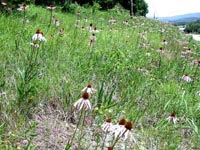Resource Library
Plant of the Week: Drooping Coneflower
The University of Arkansas System Division of Agriculture does not promote, support or recommend plants featured in "Plant of the Week." Please consult your local Extension office for plants suitable for your region.
Plant of the Week
Drooping Coneflower
Latin: Echinacea pallida

As springtime washes over Arkansas with its exuberance of flowers and greenery, we must pause a moment and morn a passing. Carl Hunter, the grandfather of the wildflower movement in the state, passed away on March 23 after a bout with pneumonia. He was 81.
Carl was passionate about Arkansas, wildflowers and all of nature. He didn’t seem to play favorites about the natural world, but as a wildflower expert he did recommend plants that were well suited for general garden conditions. At its peak, his own garden contained 160 of the 600 wildflowers he described in his 1984 book, Wildflowers of Arkansas. He recommended the coneflowers for use in wildflower gardens and grew drooping coneflower (Echinacea pallida) in his own.
Drooping coneflower comes into bloom in early May, occurring in the woodland parts of the state on sunny, droughty banks. The solitary flowers are a pale pink to whitish-pink with petals drooping downwards and as much as three inches long. Plants reach 3 feet tall when in bloom. The dark cone is an inch long and persists after the flowers fade, providing seed to passing songbirds.
Carl G. Hunter (1924-2005) was a Little Rock native who attended college at Little Rock Junior College (now UALR) and earned a degree in agriculture from the University of Arkansas in Fayetteville in 1945. After graduation, he married his college sweetheart, Mary Ann Scott, and accepted a job with the Arkansas Game and Fish Commission as a wildlife biologist.
In 1957, Carl left that job to manage an 11,000-acre rice farm in Prairie County. In 1977, he returned to the Game and Fish Commission as assistant director, where he remained until his retirement in 1987. In 1989, he published the companion volume to his wildflower book, Trees, Shrubs and Vines of Arkansas. These two volumes are still in print and have become the standard reference for nature lovers and gardeners as they explore the botanical wealth of the state. In addition to these, he published four other books, three of them fiction works.
Carl was a tireless worker on behalf of the natural heritage of Arkansas. He spoke to countless groups throughout the state about wildflowers and fostered the use of wildflowers along Arkansas roadways. His efforts, combined with a general shift in thinking about roadside management, lead to the reduced use of herbicides along Arkansas roadways and changed mowing schedules. This policy shift allowed wildflowers to reestablish a foothold in the 200,000 acres of roadways throughout the state.
To leave the world - or at least your little corner of it - a better place for having passed this way is the ultimate mark of a successful life. Carl Hunter achieved this distinction through his enthusiasm for the natural world, his selfless support for groups and organizations supporting wildflowers, such as the Drooping Coneflower, and by making all of us just a bit more aware of the beauty surrounding us.
By: Gerald Klingaman, retired
Extension Horticulturist - Ornamentals
Extension News - April 8, 2005
The University of Arkansas System Division of Agriculture does not maintain lists of retail outlets where these plants can be purchased. Please check your local nursery or other retail outlets to ask about the availability of these plants for your growing area.